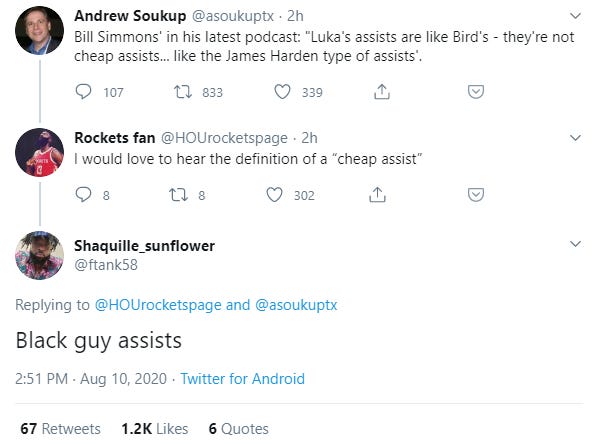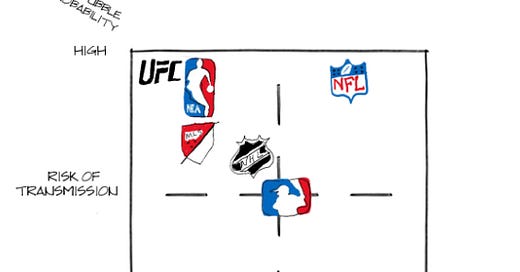Save the Lottery is a landmark achievement in the histories of both basketball and email. Why not subscribe, or forward to a friend?
OPENING TIP
The blood-dimmed tide is loosed, and everywhere
The ceremony of innocence is drowned;
The best lack all conviction, while the worst
Are full of passionate intensity.— William Butler Yeats, “The Second Coming”
Sports, baby! The NBA is back, it's fun, and pundits are already suffering from a bout of premature congratulation.
Major League Baseball is also back. Sorry, wrong link.... is also back... nope. Hang on… Major League Baseball is… Let's just move along.
Meanwhile, the NFL is seriously considering having a plan to restart it's season.
At STL, we believe the underlying framework for how leagues are thinking about their seasons is slightly more nuanced than “Rob Manfred is a war criminal.”
Time and again, leagues appear to prioritize profitability over all else. Labor negotiations, misplaced adventurism, exploitation and corruption, and good old fashioned cover-ups are all just drops in an increasingly heavy bucket and can be distilled down to the reality that sports leagues are first and foremost economic entities.
We believe the leagues’ comments that they are focused on player health and safety upon reopening. However, the deployment of safety measures—particularly whether or not to establish a quarantined “bubble”—is nevertheless an economic calculation based on the incremental benefits of these measures relative to their logistical and organizational complexities.

UFC, forced to examine questions like “can you spread COVID by bleeding directly into a co-worker’s mouth?” is an excellent example of a high transmission risk sport. As such, league management’s desire to relaunch fight events met significant internal and external resistance. Setting up Fight Island as a quarantine zone was logistically straightforward, and enabled the league to return swiftly to the sadly missed receiving of checks from broadcasters, sponsors, et al.
On the other end of the spectrum, Formula 1’s approach—based on social distancing, testing, and contact tracing—has thus far been effective at limiting the spread of coronavirus while enabling five successful race weekends since the promotion reopened. F1 enjoys the advantage of not operating in areas most popular with the Novel Coronavirus set, but setting up a bubble in one location for the rest of the season was never under serious consideration. The promotion relies on fees from over a dozen different international venues and would have faced prohibitive logistical challenges associated with quarantining 130 race-day personnel per team and over 3,000 essential employees per event. Also this is how you dress to go to work.
In the case of the NBA, the league office and team owners were able to “persuade” hesitant players on the merits of a bubble by gently reminding them that failure to complete the season would be frowned upon by broadcast partners and could result in a voiding of the existing CBA via force majeure. It is perhaps not surprising that players arguing for not getting paid now or later did not prevail. Player resistance was also likely somewhat muted given that players could opt out for health reasons if they wanted to and most players would be signing up for just three to five weeks of games.
Major League Baseball’s decision to open sans bubble, on the other hand, has been influenced by both greater logistical complexity and stiff resistance from players who were reluctant to commit to six months bubbled up in Sarasota and Glendale.
But decision-making isn’t static. It’ll be interesting to see how sports league approaches evolve as their evaluations of bubble benefits and challenges continue to develop. The MLB could move up and to the left on our chart—increasing the likelihood that a bubble is implemented—when player willingness to quarantine increases as it becomes clear the “plan” isn’t “working”.
Meanwhile, the NBA could move to the right when it comes to planning the 2021 season as players are forced to confront the reality that they may be asked to quarantine for six months instead of five weeks. But then again, perhaps NBA players have grown fond of Orlando. After all, who could fail to have their heart captured by the splendor and enchantment of the Magic Kingdom? Slouching towards Disney… at least it’s better than Alberta.
TWEET OF THE WEEK (😳 EDITION)

SOME GOOD READS
Should we be concerned about Zion? While his scoring numbers continue to be great, sports medicine doctor Brian Sutterer expressed grave concerns to Ethan Strauss at The Athletic about Zion’s injury track record and decline in explosiveness, which Nate Duncan later echoed after reviewing Zion’s Duke film. Keep in mind that Dr. Sutterer is still a resident, looks like he’s 12 years old, and is unabashedly trying to become “the Sanjay Gupta of sports,” so there is reason for skepticism. But Pels fans have reason for concern.
Seth Partnow examines why bubble ball is so great (subscription required) using player movement data. It isn’t just your imagination: they really are flying around more than pre-COVID!
How the NBA is beating COVID-19. In part, superior resources:
But here’s where the NBA is especially well resourced: When these outlier findings occur, they have the resources to a) get results in hours because of the deal they negotiated with BioReference Laboratories, b) use a second test on that same person and then c) also administer a second kind of test. In very rough numbers, the U.S. has about one PCR test per 450 people per day. The NBA has at least one PCR test per person in the bubble per day.
Without all those tests, the answer would often be to quarantine for two weeks to be on the safe side. In the NBA, players can be back on the court less than a day after an inconclusive test result.
Coaches in the bubble are allowed to wear casual attire. Some aren’t having it:
Vogel was wearing his only suit -- a graduation gift from his parents. He told Pitino he was going to wear it for each game, and change out shirts and ties to avoid detection. Pitino would not have it. He invited Vogel to his house that night, and gave him 15 suits -- Armanis and Brionis -- plus the number for his tailor, Vogel recalled.
PLAY OF THE WEEK
The pass heard round the world.

AT THE BUZZER
Counter the countermove: the one-dribble three is replacing the catch and shoot three as defenses adjust to defend catch-and-shoots.
The NBA’s wine club: like yours, but a lot more expensive.
Dartmouth’s model for NFL safety (let’s see if Goodell is listening).
“Stares are getting colder getting on and off the elevator.” Tension at the Yacht Club.
Are the Delete Eight heading to the bubble? (Maybe not)
A Zach Lowe nerdfest: Jimmy Butler hates threes, TJ Warren is a beast, and Devon Booker can pass, among other topics.
JJ Redick finally misses the playoffs after 13 years.


